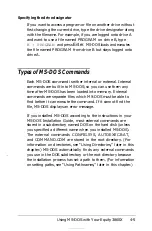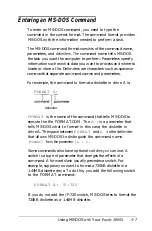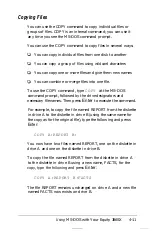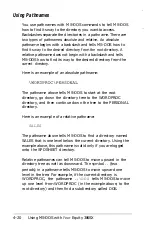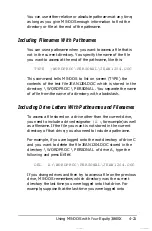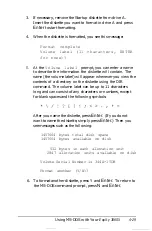
The Current Directory
MS-DOS always recognizes one directory as the current (or
default) directory, just as it always recognizes one drive as the
current drive. The current directory is the directory you are
logged onto at the time and the one in which MS-DOS
performs your commands, unless you tell it to do otherwise. If
you installed MS-DOS according to the instructions in your
MS-DOS Installation Guide, the MS-DOS command prompt
displays the current directory.
If you want to run a program or access a data file that is not
stored in the current directory, you can either change
directories (making a different directory the current directory)
or include a pathname in your command.
Changing the Current Directory
To change from one directory to another, use the CHDIR
command, or its shorthand equivalent, CD. For example, to
change to the root directory of the current drive from anywhere
in the directory tree, type the following and press
Enter:
CHDIR \
If you are in the WORDPROC directory and you want to
change to PERSONAL, a subdirectory of WORDPROC, type
the following and press
Enter:
CD PERSONAL
To change from PERSONAL back to WORDPROC, you can
use the special symbol . . (two periods). The . . symbol always
designates the parent directory, which is the directory one level
above the current directory. You can type:
CD . .
Using MS-DOS with Your Equity 386SX
4-19
Summary of Contents for Equity 386SX PLUS
Page 1: ...m u cl3 0 z E 5 J I 1 al y 8 c 7 5 w ii u l X ...
Page 4: ...EPSON E Q U I T Y 3 8 6 S X User s Guide Y19299100100 ...
Page 20: ...6 Introduction ...
Page 38: ...1 18 Setting Up Your System ...
Page 69: ......
Page 70: ...2 32 Running the Setup Program ...
Page 96: ... 7 R _ ri h 14 3 26 Using the Equity 386SX ...
Page 168: ...5 26 dling Options ...
Page 192: ...B 4 Power on Diagnostics ...
Page 232: ...C 40 Performing System Diagnostics ...
Page 246: ... D 14 Physically Formatting a Hard Disk ...
Page 250: ...E 4 Hard Disk Drive Types ...
Page 282: ...8 I n d e x ...
Page 284: ......

